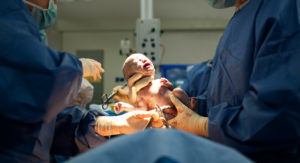A primary c-section means a c-section done on a woman who has had no previous c-section. At Brockville General Hospital, we are happy to report that our primary c-section rate is less than 15%, which is the target suggested by the World Health Organization. Primary c-sections are done for many reasons. Sometimes the baby or the placenta is positioned in such a way that vaginal delivery is not possible, or may carry more risk. Sometimes we see changes in the fetal heart rate while in labour that can indicate that the baby is in trouble. If the cervix is not fully dilated, the only way to get the baby out quickly in that circumstance is a c-section. Sometimes the cervix just will not dilate past a certain point, no matter how strong the contractions. Sometimes the baby does not descend through the birth canal with pushing. And some women, for their own personal reasons, will choose to have a primary c-section without labour.
A c-section, although a relatively safe surgery in Canada, is a major abdominal surgery. Usually a bikini-line skin incision is used, and most often a similar transverse incision is made on the uterus. Every surgery has a risk of bleeding and a risk of infection. We always ask if blood transfusion would be okay if it became necessary to save your life, although it is rare that we need to do this. Infection is usually fairly easily treated with antibiotics especially if it is caught early, but sometimes part of the incision needs to be opened or drained, and rarely an abscess could form requiring drainage or even surgery. When we operate on the uterus a number of major structures are in close proximity – the bladder, the bowel, the ureters (that connect the kidneys to the bladder), and major blood vessels are all nearby. There is a small risk of damage to any of these structures during surgery. If that were to occur you could become quite sick and could require further surgery to manage complications. Although exceedingly rare, death is possible. Post-operatively, developing blood clots is rare but possible. These can form anywhere, but most commonly form in the legs. In some cases, these blood clots can break off and travel to the lungs where they can cause a pulmonary embolism, which can be fatal in severe cases. We use special compression stockings to help to prevent this complication, and we will encourage you to get up and move around soon after surgery to decrease this risk as well.
After a woman has had one c-section, in future pregnancies she will need to decide how she wants to deliver. There is a small risk of uterine rupture (separation or opening of the scar on the uterus) in future pregnancies, which is highest during labour. This can be a dangerous complication for you and for the baby. For this reason, a woman with a previous c-section may choose to have a repeat c-section without labouring in a future pregnancy. However, the risk of uterine rupture is small, and trying to have a vaginal delivery is an option. C-sections become more difficult to perform and are associated with higher risks of complications with each successive c-section due to scar tissue. Having a scar on the uterus also increases the chances of the placenta implanting abnormally (which increases the risk of bleeding and hysterectomy) and this risk increases with the number of c-sections that a woman has had. For these and many other reasons, we support attempts to have a VBAC (vaginal birth after c-section) at Brockville General Hospital. The likelihood of a successful vaginal birth after c-section is high, especially if the reason for the first c-section is unlikely to recur. Please see the VBAC page for details.
A repeat c-section is a c-section done on a woman who has had a previous c-section. These are either scheduled and usually take place before labour occurs, or are done as a result of an unsuccessful attempt at VBAC. Repeat c-sections can be scheduled no earlier than 39 weeks if a woman chooses to deliver this way. If she goes into labour prior to 39 weeks, the c-section is done at the time that labour occurs if she still chooses to have a c-section. Some women choose to try to have a VBAC if they go into labour spontaneously prior to a certain date, at which point a repeat c-section is scheduled if labour has not occurred, rather than continue waiting or trying to induce labour.
